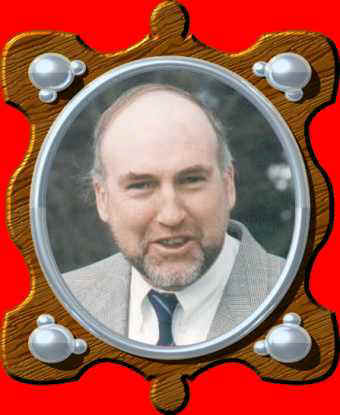
Councillor Stuart Hughes. What are his qualifications?
How traffic lights destroyed the heart of Sidford.
If anyone has a similar story to tell about the knock-on effects of road alterations, or if you are an experienced traffic engineer and could offer an opinion, please contact me. Also, if 'Spanish style' speed control traffic signals are used anywhere in the UK, please let me know. (Details of another case where installation of traffic signals made matters worse have been added as a postscript - see end of webpage).
This webpage documents how the once thriving village of Sidford was essentially destroyed by a set of traffic lights that were only installed because South West Water could be forced to pay for them (as a piece of planning gain when they built the new Sidmouth sewage works). The other key factor was that councillors led by a senior 'raving loony' were in favour. The whole episode remains an indictment of how local government operates in England today. Towards the end of the webpage there is a brief discussion of Spanish-style traffic speed control. There is also discussion of other cases where reduction in 'junction capacity' has led to queues that were not experienced before traffic lights were installed.
The central lesson of the debacle at Sidford may be that to avoid the problems that can be created when inadequate councillors force their ideas through, traffic planning for complex junctions should be taken out of the hands of local government. Proposals should be examined at the design stage by outside experts. Local officials and councillors (in this case from Devon County Council (DCC)) could be left to decide on the width of yellow lines and the colour of parking cones.
There follows (in blue, below , click to go there) a report I wrote for the Sidford Village Action Group during the long summer of protest against the traffic signals. It was presented to a meeting of District and County councillors who knew perfectly well that the issue had generated more protest from 'intelligent and respectable' citizens than any other in Sidford - with the possible exception of the multi-storey car park protests that I encouraged a year or two earlier. They ignored it, which was behaviour typical of Sidmouth and East Devon District Council's (EDDC's) entrenched elite of councillors who know they will be re-elected simply because they wear a pom-pom of the appropriate colour. I have said many times in the local paper that the remedy is in the hands of residents - use your vote. Nearly twenty years were to elapse before just this happened - many local councillors were replaced by independents and several sizeable protest movements (save Our Sidmouth and the East Devon Alliance) were formed in around 2014 to argue against the dictatorial attitude of EDDC in particular.
An indictment of Councillor Stuart Hughes.
Always a busy junction in the summer, the only difficult manoeuvre at Sidford Cross was to travel from Sidmouth turning east along the A3052. This turn was made difficult by the excessive speed of traffic travelling west along the A3052, around a 'blind' bend. If the speed of vehicles on this main road could have been reduced, no other measures would have been necessary. The traffic signals cured the one difficulty of turning right but introduced several other problems. These occurred because the junction capacity was reduced, and this was a critical factor because the road was fully loaded at peak times.
(If you alter a road junction so as to reduce its capacity, it may not matter too much so long as the road is used at well below peak capacity. However, reducing the capacity when the loading is high may introduce far greater queuing than before. Whether the 'knock-on' effects matter will depend upon location. A large increase in noise and pollution in a village centre known for its 'inversion layers' may be much noticed by residents. A similar increase at a road junction in open country may go unnoticed and imposition of traffic signals might indeed on balance constitute an improvement.)
Amongst the consequences at Sidford Cross were much increased average waiting times and pollution in the village centre. Senior DCC Environment Department staff admitted to me that no study was undertaken of environmental side effects of installing traffic signals. DCC traffic engineers admitted that they were usually asked to advise on the suitability of traffic signals when councillors asked for them. However, in this case, because of the unusual planning history, councillors were congratulating themselves in having forced South West Water to pay for the most expensive of all alterations to Sidford Cross. Of course, in the eyes of simple people, the most expensive solution will always be the most appropriate. Traffic engineers were presented with a 'fait accompli' and told to get on with it.
In off-the-record discussions with members of the Sidford Village Action Group, highway engineers were asked about proposals to disable the signals by cutting some of the underground cables. "It wouldn't worry me" said one seasoned officer "but if you cut the power cables just make sure you take the fuse out first". He probably didn't know he was talking to a scientist with a PhD.
The chief 'culprit' in the eyes of the Sidford Village Action Group was Councillor Stuart Hughes, a man who came to fame more than a decade earlier in Sidmouth by painting his house in the colours of the Union Jack and standing for election as a supporter of the Monster Raving Loony Party. His home is still listed in the local area guide to guesthouses as "Fawlty Towers", 102 Temple St, Sidmouth. This is despite rumours that he gave up his B&B business some years ago. Many people think he should have stayed a member of the Raving Loonies or indeed, returned to Yeovil from where he is said to have originated.

Councillor Stuart Hughes. What are his
qualifications?
However, in order to get councillors from the entrenched majority party to talk to him, he saw the light and was converted to Conservatism. He was (and still is) the County Councillor for the ward that includes Sidford and as such was responsible for highway matters, which are a County (DCC) not a District (EDDC) responsibility. During the entire 'long hot summer' of protest in the village of Sidford, Councillor Hughes was not seen once by any of the residents or shopkeepers who were protesting. He never even came to discuss the reasons for what was (by the standards of sleepy Sidmouth) a huge and unprecedented protest. This involved several village meetings in a packed hall, banners, placards, TV cameras and local radio. Councillor Hughes was invited to attend meetings of the Action Group, and did not appear. Hundreds of normally quiet residents, most of whom were near or over retirement age, attended protest marches.
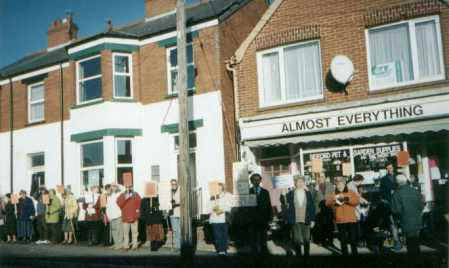
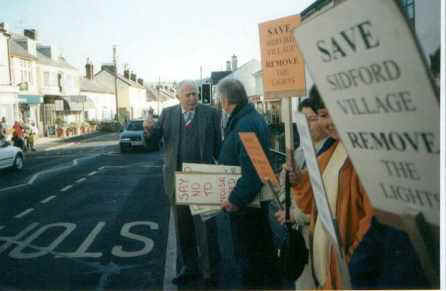
Placard waving
demonstrators, autumn 1999. Sir Peter Emery, then
the MP for East Devon, is seen talking to Tony Bell of 'Almost Everything'.
Senior local councillors were nowhere to be seen.
A motorcade into town attracted a dozen or more cars decorated with balloons and banners. Sidmouth had never seen anything like it. Several police vehicles and motorcycle units prowled the streets in case an elderly resident should misbehave with her walking stick. Uniformed officers drafted in from Exeter (the nearest large city) stood guard outside the home of Councillor Hughes - their feeble excuse being that they were ensuring safe passage for the motorcade across a nearby pedestrian crossing! The lead vehicle was a venerable SAAB (driven by the author of this website) and on its roof was a large board made from a recycled door (no expense was spared!) and bearing the phone number of Councillor Hughes. He entered a formal complaint about the local Sidmouth Herald newspaper printing a photograph of my car, citing invasion of privacy. The complaint was rejected. Some of the local newspaper headlines can be viewed on a separate page (download time c. 40 seconds).
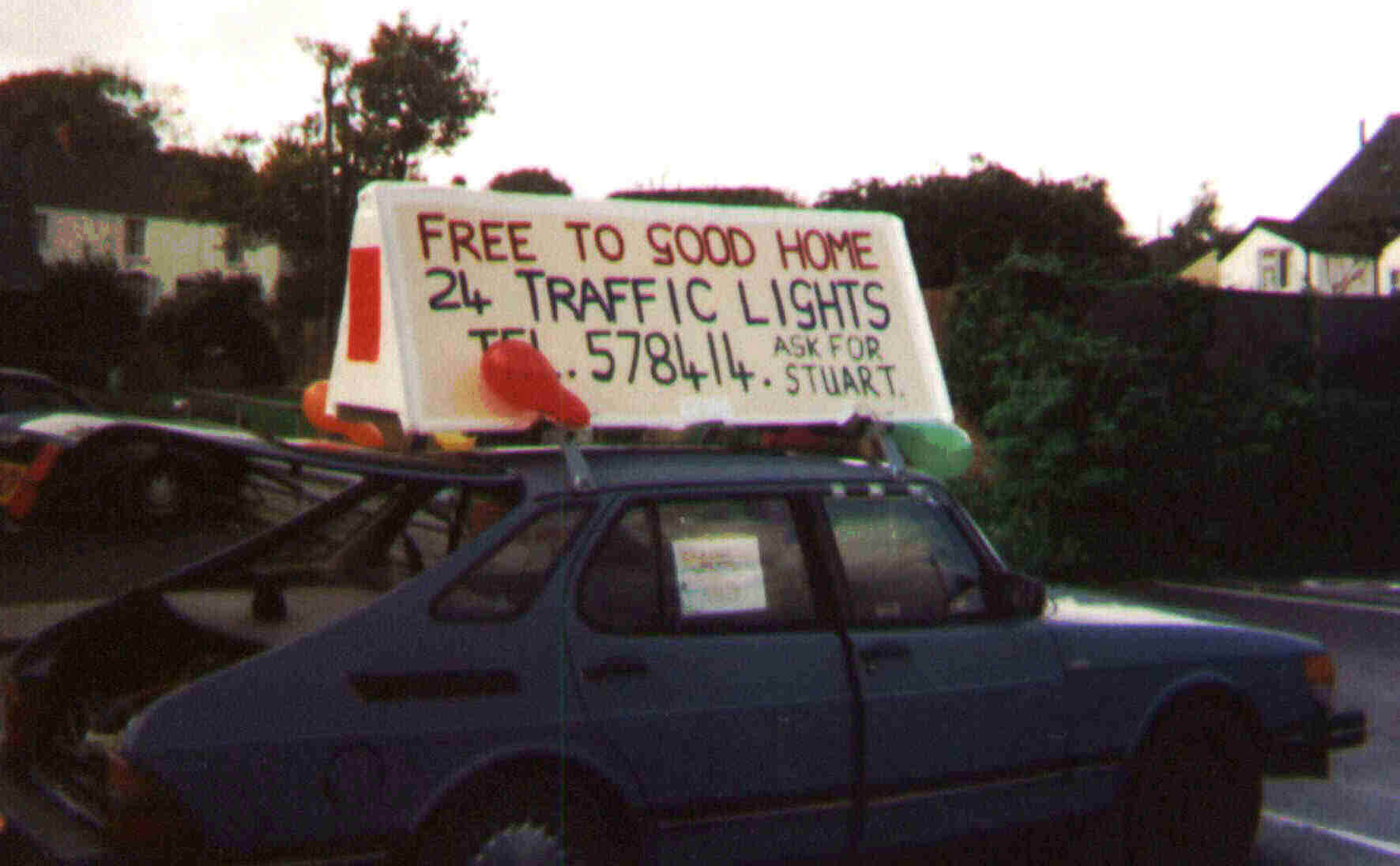
Lead vehicle in the Sidford Motorcade 23 October 1999
The major indictment against Councillor Stuart Hughes remains his failure to attend the scene of the 'crime' and to discuss with residents and traders, many of whom had seen their takings reduced by up to 50% as elderly residents found the new traffic arrangements too much for them. The main problems were noise, pollution and decreased amenity of the pedestrian crossing. Most of the shops have since closed. Maybe he was afraid.
The job of a councillor is to represent the views of the people who elected him (or her) and to discuss issues of local importance with them. Councillors cannot, of course, represent all the views all of the time but should always be able and willing to meet residents and to defend their decisions and the positions they took in Council. The more mature of them are able to admit that sometimes they were wrong.
Councillor Stuart Hughes showed that he was unwilling to attend and in the opinion of many he remains a man unfit for public office. Nevertheless he will (no doubt) be elected for decades to come, provided he keeps the party whip. He remains popular in the town partly because of involvement with the local 'carnivals'. His ward as a County Councillor covers a wide area and includes many people whose only view of Sidford is as a motorist passing through. They do not live here, and some cannot understand what all the fuss was about. One of many posters used in the village is shown below. The hall was packed to capacity with local people.
VILLAGE MEETING
TUESDAY 17 AUGUST 7.30 pm in the village hall
TO DISCUSS THE TRAFFIC LIGHTS AND THEIR EFFECT ON VILLAGE LIFE
Following failure of Sidmouth Town Council properly to discuss and comprehend the problems
it has caused, a meeting is being called for residents and traders of Sidford.
Admission will be free but DONATIONS ARE NOW REQUESTED to help meet the costs of producing
posters, literature etc. for what could be a protracted campaign to save village life.
Collection tins are now located at many village businesses.
If you have not yet signed the petition
against the traffic lights please do so now in any shop.
Of course, it is not only at the local level that people have lost faith with their 'elected representatives'. Arguably, it is now the Press who have become our (unelected) representatives. Daily, we take sides with well known interviewers on Radio 4 as they inflict upon politicians what we feel they richly deserve. The low esteem in which voters hold politicians and especially Members of Parliament was highlighted by a poll taken in May 2002 by the Today programme on BBC Radio 4. People were asked to rate the professions which they most respected and least respected. Out of 92 categories of occupation, Members of Parliament came bottom. They even managed to beat Estate Agents (91/92) and Government Ministers (90/92). Local government officials fared a little better at 77/92. For an explanation of how the poll was conducted and the results calculated see http://www.bbc.co.uk/radio4/today/reports/features/professions_vote_results.shtml). An article in the Spectator (23 November 2002) put it well:
There is a line peddled by New Labour apologists that it is the likes of Jeremy Paxman and John Humphrys who are responsible for the lack of faith the young have in politics. If Paxman makes out that they're all lying bastards, goes the argument, is it any wonder that politicians aren't trusted? Yet the real question is why are ministers so afraid to go head-to-head with these inquisitors? Those with integrity come out well, if bruised .....
As a footnote to the analytical ability of Councillor Hughes, and a matter that will be explored in the forthcoming webpage on the multi-storey car park in Sidmouth (see main summary page for brief details), he remains the only person to my knowledge who could at one and the same time argue vehemently both for a multi-storey car park in Sidmouth (which would have ensured a high throughput of cars in the area) and for pedestrianisation of the town centre (which would have precluded access). However, Councillor Hughes is not a scientist. He is a politician, a man who knows that votes may be collected from an unthinking electorate by promising all things to all men. During the traffic signals protest the local MP eventually came and made promises that were subsequently lost in the mists of time. A Press Release summed it up.
PRESS RELEASE 22 November 1999
from: Sidford Village Action Group
On Saturday 20 Nov, Sir Peter Emery spent over an hour listening to Sidford residents
complain about problems caused by traffic lights in their village. He was also told of the
deep disaffection for some local Conservative councillors - especially for County
Councillor Stuart Hughes who was accused of having been primarily responsible for having
the lights installed, and yet who had steadfastly refused to come to the village to
discuss their operation. Sir Peter had indicated he would bring some Conservative
councillors with him. None turned up.
Over 50 demonstrators with placards and standing in silent protest met Sir Peter at 11 AM.
The visit started on a confrontational note with Sir Peter telling several members of the
Action Group that they did not know what they were talking about. He also embarked on a
brisk defence of Conservative Sidmouth councillors.
For over half an hour Sir Peter stood his ground, declining to believe stories about the
behaviour of councillors and the extent to which the traffic lights had degraded life in
the village centre. He also dismissed claims of lost trade for the village shops, saying
that small shops had been closing for years. These arguments carried little weight with
villagers several of who then described their own experiences of living and working
locally. Sir Peter said that all these concerns should be written down and discussed in a
non-emotive way. He was then told that this was precisely what the Action Group had been
doing for five months, only to be all but ignored by officials and councillors alike. Sir
Peter was handed a copy of a summary document that had been submitted to the East Devon
Partnership Committee on 15 November - factual and non emotive, it had been ignored
despite the promise by officials of some debate.
During a discussion with local resident and farmer Bob Elliott, it was suggested that the
lights be switched off for six weeks to assess the difference in village ambience. Sir
Peter said he thought this was an excellent idea but that it could not be done until after
the Section 106 agreement (under which the lights had been installed) had expired. It was
pointed out to Sir Peter that all this ground had been covered by the Action Group, and
that a DCC official had stated at a Development Control meeting that there was no reason
why a S. 106 agreement could not be altered by agreement of all parties. Indeed, this had
already happened in Sidmouth recently on another project.
Later, Sir Peter retired to the Myrtle Tree Tea Rooms for a summary discussion with Action
Group Members Tony Bell, Christine Potter and Stephen Wozniak. Two town councillors who
have supported the group, Jack Brokenshire and Rosemary Murch, also attended.
The Action Group believes that Sir Peter's visit could prove to be a turning point in
their campaign. Despite his initial attitude, which paralleled that of many local
Conservative councillors, Sir Peter later conceded that many points could be valid. In
particular he was asked to pursue the idea of a six week switch off period for the lights,
to be commenced as soon as possible and with monitoring of the village during this period.
This suggestion had previously been made by the Action Group in their summary paper for
the Partnership Committee.
I would be pleased to know if there are any examples in the UK of 'Spanish style' traffic lights that are used with speed sensors to slow traffic on the approach to villages that straddle main roads. They work by staying at amber if you do not approach too fast, so you benefit from a smooth trip. If you approach too fast they turn red to stop (and thereby inconvenience) speeding vehicles. Few people risk running a red light and friends and neighbours who visit and live in Spain say they work splendidly - and I have recently been told they are used in Portugal too. Enforcement is also easier - a police officer does not need a radar gun. Merely seeing a vehicle going through a red light is quite sufficient evidence (as would be video taken by any local residents).
The beauty of the Spanish solution is that for a heavily loaded main road the several sets of lights stop traffic only when it is speeding. At all other times full road capacity can be realised. Outside of peak hours, traffic on the main 'through road' can flow freely and without all the stop-start and tedious waiting that is an inevitable consequence of full (24/7) traffic signal junction control at a staggered cross roads like Sidford Cross. If the Spanish solution has been used in the UK please tell me. However, there is probably a 'not invented here' clause that prevents this. Experience of a similar but 'advisory' type of electronic speed detection sign has proved promising in Sidford and may be a viable alternative to detested road humps - see the road humps section.
Letter in the local Sidmouth paper (30 November
2001)
Spanish lesson
I have just returned from a motoring holiday in northern Spain and while I do not often
agree with Dr Stephen Wozniak's views, his comments about traffic control are spot on.
The sophisticated traffic lights in Spain that he refers to are very effective indeed in
controlling both the speed and flow of vehicles.
Ten to 20 years ago, Spanish road engineers appeared to bypass everything, even the
tiniest hamlet, but the new lights they have now adopted do a good job and, unlike
bypasses, are cheap, do not kill off the traders in the villages, or ruin the environment.
Perhaps someone in Devon County Council's road and engineers' department will read this.
Senior DCC traffic engineers have admitted to me that "every traffic engineer in the country" would like to find a solution to the problem of cars speeding through villages such as Sidford. Could a proven solution be found in far off Spain? Should all DCC traffic engineers be seconded to the Costa del Sunshine for six months to study this wonderful invention? Will it take local government in the UK another decade to reinvent the wheel? Only time will tell.
Photo, diagram and report: Sidford Cross (A3052 and A375).
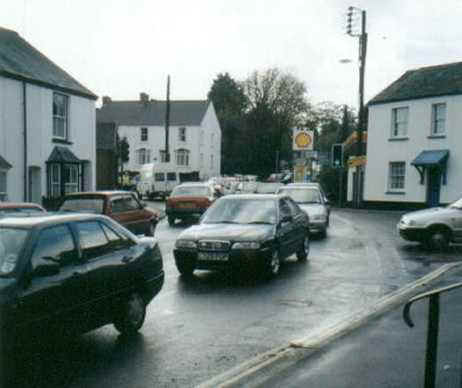
Sidford Cross seen
from the east. The old Give-way road markings are still visible
across the A375 (right of picture). Traffic congestion, pollution and noise in the
village centre remain far worse than they were before the signals were installed.
I would be interested to receive views from professional traffic engineers on the following report. In the diagram, the main A3052 coast road is west to east (A to B). The road into Sidmouth is C and the only difficult aspect of the junction before the signals were installed was to exit from C turning right to travel east (B), because of the speed of traffic around a 'blind' corner. Matters are complicated by a petrol station at P. In summer the A3052 is very busy, and a lot of holiday traffic arrives from the north (D). The primary traffic signals are now installed at locations shown as dots. Three stage control is used, road C green, then A and B together, then D, then A and B again, then C again.
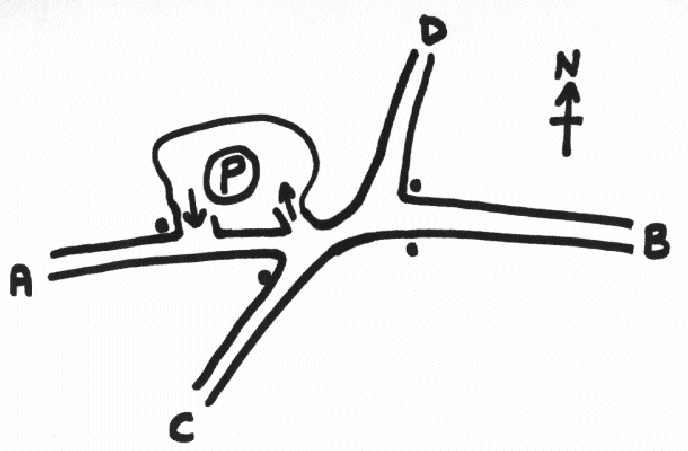
Submission to East
Devon Partnership Committee: 15 Nov 1999
Traffic signals at Sidford
History
Sidford Cross is a double staggered T junction with one 'difficult' right turn. Suggestions for either mini-roundabouts or traffic signals have been made over many years but the low accident rate has not merited DCC funding.
In c 1997/8 mini-roundabouts were dismissed by DCC on the basis of a flawed and inadequate analysis of accident data. This was one factor that led in July 1999 to installation of traffic signals at the request of the Development Control Committee, in the belief that signals would facilitate safer movement of construction traffic through the junction. However:
At a meeting in March 1999, the Partnership Committee recommended monitoring of the performance of the signals, to enable a view to be formed on whether they should be retained at the end of the SWW construction period. No detailed parameters were set for the study.
Experience to date
The traffic signals were installed during June 99, a peak month for construction traffic and with significant holiday traffic. The installation phase was fraught with problems and all roads experienced far greater congestion. This was blamed on the 'unsophisticated' control logic of the contractors' temporary signals.
However, within days of the 'permanent' signals being commissioned and 'adjusted' it became clear that there were serious problems with both traffic flow and village amenity. These have continued, albeit some problems are less noticeable in the low loading of autumn traffic:
Monitoring
It is clear that to undertake meaningful monitoring of the effect of the signals on the life of the village, as well as on traffic, comparisons must be made between 'before' and 'after' data. It is clear also that many of the problems induced by the signals are present to some extent 24 hours a day, whereas the signals can be argued only (perhaps) to improve conditions for some motorists for a few hours a day.
Proper monitoring would be designed to elucidate: to what extent and during what period of the day and to what percentage of users of the roads and village do the signals produce a positive net benefit, compared to the negative impacts on village life during all hours.
Under the monitoring agreed by the Partnership Committee previously, DCC have commenced a 'standard' series of exercises designed more (so it would appear) to address motorist-centred issues than as a serious attempt to answer germane questions in the context of village life and 'sustainability' of a small community.
Proposals
Because many of the key parameters can only meaningfully be assessed with reference to how the junction and village behaves with and without the signals in operation, and given that ample evidence is available of the problems that have been experienced over the last four months, it is proposed that
the signals should forthwith be disabled for a period of six to eight weeks and the junction reinstated to 'give way' operation. All that would be required would be some signing, covering up the traffic signals and reinstating the original white lining.
Thereafter and notwithstanding the expected concrete pour at the Ham in February, it is proposed that
the signals should not be brought back into operation unless both a proper theoretical study of the junction and practical experience during the six to eight week experimental period suggest they would have overall net merit especially during summertime.
It is furthermore proposed that
the in depth theoretical study should include double mini-roundabouts and/or remodelling of the junction via land acquisition and that the flawed accident analysis previously undertaken by DCC be discounted.
prepared by Dr S J Wozniak on behalf of Sidford Village Action Group, November 1999
Postscript.
Since this webpage was first published two other cases have been notified to me where installation of traffic signals made road conditions worse. The first was at what is called the 'five lamps' junction in Derby (see next page) and the second I have experienced myself more recently - it is a slip road off the M5 in south-west England. Again, local people had warned of the possible consequences. Any further examples would be welcome.